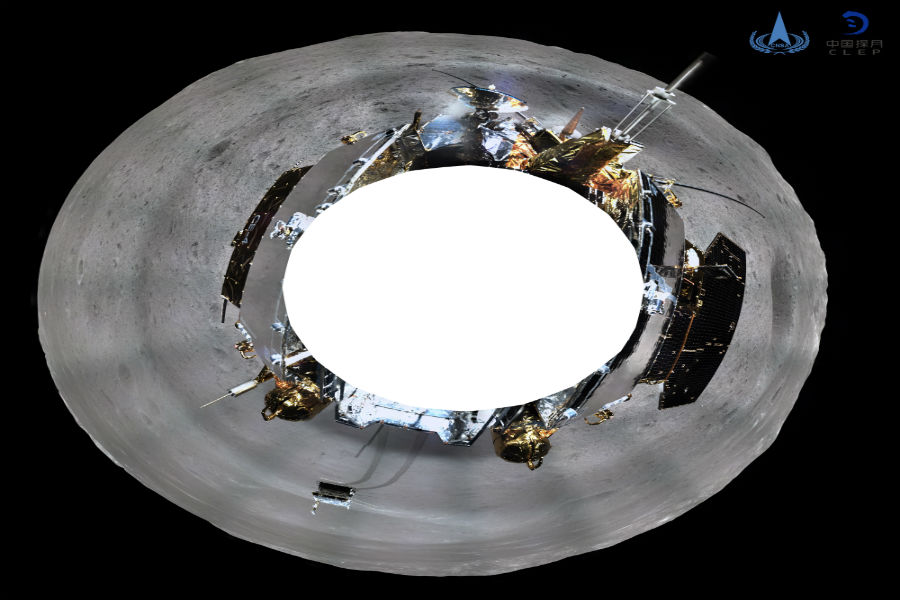Chang’e-4: Lonely Landing

Since ancient times, Chinese people have aspired to explore the moon. According to a fairy tale known throughout China, the moon is inhabited by Chang’e, a woman who drank an immortality elixir and ascended to heaven as a goddess. She is accompanied by the Jade Rabbit, who persistently grinds medicine in a mortar, and a 1,600-meter-tall laurel tree that can never be cut down.
In 2004, after more than a decade of research and planning, China’s lunar exploration program was officially launched. Chinese scientists romantically named the program after the goddess of the moon and its lunar rover Yutu (Jade Rabbit), the pet of the goddess Chang’e. Since then, several Chang’e missions have been completed, evidencing an increasingly accelerated pace of Chinese exploration of the moon. Chang’e-1, Chang’e-2 and Chang’e-3 lunar probes were successfully launched in 2007, 2010 and 2013, respectively, all of which accomplished their missions. In December 2017, China announced plans to complete the Chang’e-4 mission through two launches in 2018: It would launch the Queqiao (Magpie Bridge) relay satellite in the first half of the year and the Chang’e-4 probe in the second half.
On May 21, 2018, a Long March 4C rocket carrying the Queqiao relay satellite blasted off from Xichang Satellite Launch Center in southwestern China’s Sichuan Province. After a series of complicated orbital maneuvers, Queqiao entered the L2 halo orbit about 65,000 kilometers from the moon. It became the first satellite to reach the location, with a mission to relay communication between the Chang’e-4 lunar probe and Earth.

On December 8, 2018, the Chang’e-4 probe was launched on its journey to the moon. On December 12, after 110 hours of flight, the probe entered an elliptical lunar polar orbit with a perilune of 100 kilometers, following a lunar orbit insertion burn. The lunar burn was a crucial orbital maneuver for the Chang’e-4 probe to reach the moon, through which the probe slowed down below escape velocity, enabling it to be pulled by the gravity of the moon and enter lunar orbit.
On December 30, 2018, after an orbital transfer, the Chang’e-4 probe entered a preset orbit to land on the far side of the moon. On the morning of January 3, 2019, the Chang’e-4 probe began its descent from an orbit 15 kilometers above the surface of the moon. At 100 meters up, the probe hovered above the surface to identify obstacles and measure the slopes on the surface. After navigating around obstacles, it selected a relatively flat area and descended vertically and slowly.
At 10:26 a.m., with the assistance of reverse thrusters and buffer equipment, the one-ton-plus probe successfully landed in the Von Karman Crater of the South Pole-Aitken Basin on the far side of the moon. At 11:40 a.m., the lander snapped the world’s first close-up photo of the moon’s far side and sent it back to Earth. At 3:07 p.m., Chinese scientists sent a command through the Queqiao relay satellite to have the Yutu-2 rover separate from the lander. At 10:22 p.m., the rover touched the lunar surface. Both the lander and the rover began their scientific work.
On January 5, the Chang’e-4 probe tested its performance in high temperatures as the sun rose to its highest point over the landing site. The Yutu-2 rover entered standby mode to protect itself from temperatures reaching as high as 200 degrees Celsius. On January 10, the rover reawakened after a “midday nap” and resumed its operation.

On the afternoon of January 11, with support from the Queqiao relay satellite, the lander and the Yutu-2 rover took photos of each other on the far side of the moon, marking complete success of the first stage of China’s Chang’e-4 lunar probe mission. Afterward, the Chang’e-4 probe entered a mode of scientific detection, with the lander conducting in-position detection and the rover conducting patrols.

The Chang’e-4 mission sets a new bar for China’s lunar exploration program. The program consists of three stages: unmanned lunar probes, manned lunar landing, and construction of a moon base. The first stage also includes three steps: orbiting the moon, landing on the moon and bringing samples from the lunar surface back to Earth. So far, China has completed orbiting and landing on the moon. The Chang’e-5 probe will take off to bring samples on the surface of the moon back to Earth around 2020, laying groundwork for future manned lunar landings.
The Chang’e-4 landing on the far side of the moon was one small step for a Chinese probe, but one giant leap for human space exploration. The infinite possibilities presented by the boundless universe are inching closer.
